Is ceramic cookware safe? This post will review whether ceramic cookware is a non toxic, non-stick cookware option, and which brands are safest to buy.
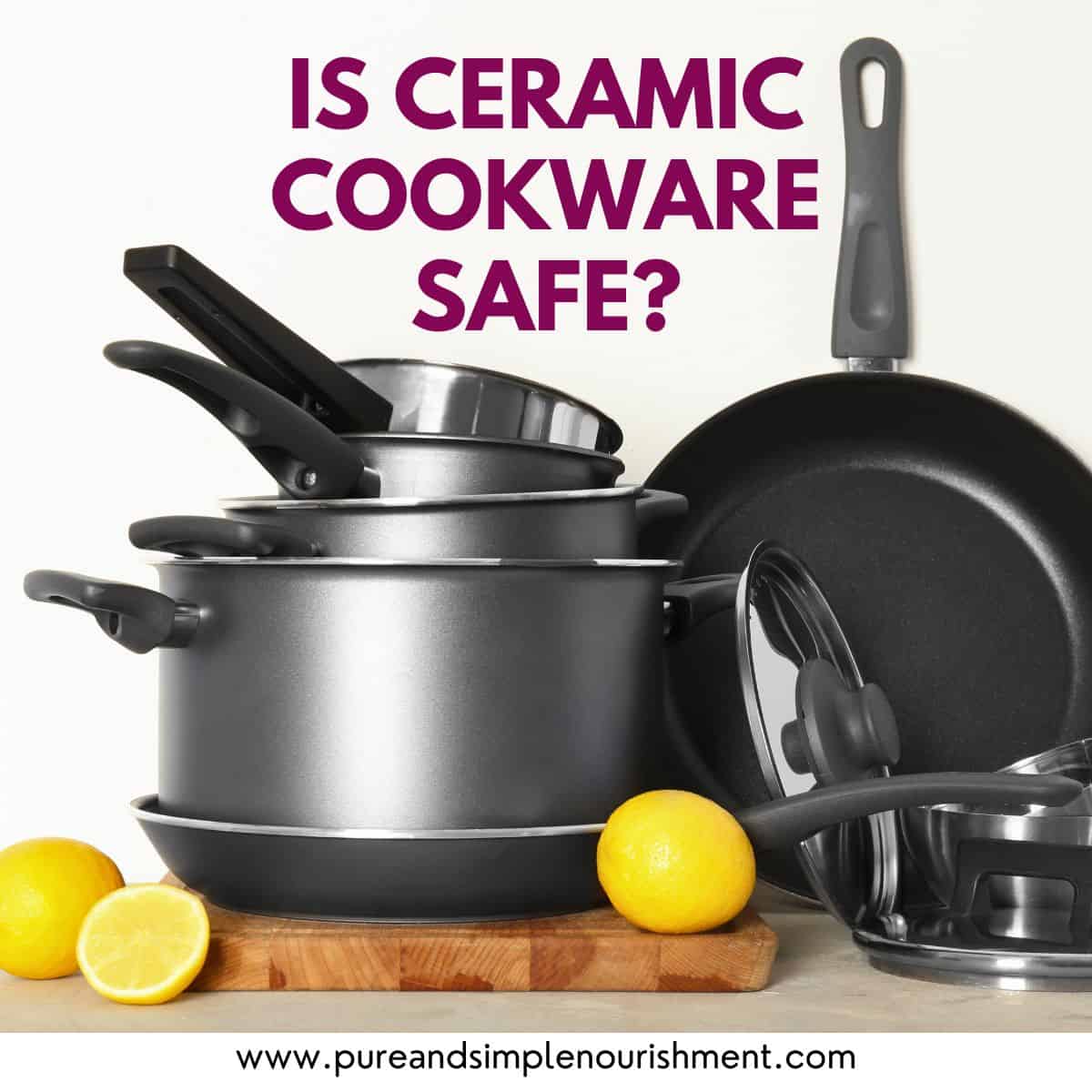
Disclaimer: Some of the links in this post are affiliate links whereby if you purchase the product through that link I make a small commission. This does not cost you anything extra and allows me to keep this website running.
Choosing safe cookware is one of the ways you can help decrease your exposure to potentially harmful chemicals that could contribute to chronic diseases. Unfortunately, there is a lot of false advertising in the cookware industry, and many brands will say their cookware is safe and non-toxic, when it really isn't. This is especially true for ceramic cookware, and that is why I wrote this post. I hope you find it helpful.
Table of Contents
- Is Ceramic Cookware Safe?
- Why non-stick cookware is unsafe
- Risks of ceramic cookware:
- Which ceramic cookware brands are safe and which ones aren't?
- Ceramic cookware brands to avoid:
- Ceramic cookware brands that might be safe:
- The safest ceramic cookware brand: Xtrema ceramic cookware
- Other safe cookware options:
- The bottom line: is ceramic cookware safe?
- Is ceramic cookware safe FAQs:
- Other cookware information you will like:
- Our expertise:
Is Ceramic Cookware Safe?
Non-stick cookware is popular because it's so easy to use. However, most non-stick cookware (the ones made with Teflon coatings and other non-stick coatings) is toxic and harmful to health. Because of this, ceramic coated non-stick cookware has become more popular. But sadly, a lot of ceramic cookware is not as safe as it's advertised, and I will review why in this post, plus share brands that are actually safe and worth investing in.
Why non-stick cookware is unsafe
Before we get into ceramic cookware, I wanted to review why traditional nonstick cookware is not safe.
Traditional non-stick cookware is made with per-and polyfluoroalkyl substances (PFAS). PFAS are a class of chemicals that provide stain and water resistant coatings. PFAS chemicals are referred to as “forever chemicals” because they are persistent, meaning they build up and don’t go away. They remain in our bodies for years, and sometimes even decades after exposure.
PFAS, even at low doses, are known to have a number of harmful effects on human health including but not limited to:
- They are endocrine disruptors (aka hormone disruptors).
- They can increase the risk of certain cancers including thyroid cancer and kidney cancer.
- Can lead to metabolic diseases including obesity, diabetes and can increase cholesterol levels.
- Can lead to heart disease.
- Can cause thyroid disease.
- Increase the risk of allergies and asthma in children.
- Can decrease sperm counts.
- Can increase the chances of miscarriages in pregnancy.
The original PFAS chemicals are called “long-chain” because they have a long carbon and fluorine chain. This includes Teflon and its related chemicals (also known as PFOA, or C8). Unfortunately, most of us have high levels of PFOA in our bodies, with more than 99% of Americans having PFOA in their serum.
Today, the production of the long carbon chain chemicals has been largely phased out, however they have just been replaced with different PFAS that have a shorter carbon-fluorine chain. The problem with these new chemicals is that their small size makes them even more persistent in the environment and even more difficult to clean up.
In other words, you want to try and avoid PFAS exposure, and one of the easiest ways to avoid PFAS and PFOAs is to avoid any non-stick or Teflon coated cookware, including pots, pans and bakeware.
Risks of ceramic cookware:
Whether ceramic cookware is safe really depends on the type of ceramic cookware you are using, as not all ceramic cookware is created equally. When looking at ceramic cookware you can get pure ceramic cookware, ceramic coated or ceramic enameled cookware, or glazed ceramic cookware. It is the ceramic coated cookware, the ceramic enameled cookware, and the glazed ceramic cookware that you need to be cautious of and I will review why in the following sections.
1. Nanoparticles in ceramic coated cookware
Nanoparticles are very small particles. Because of their small size, they can easily enter bodily tissues, and some of them can lead to health problems. For example, asbestos is an example of a nanoparticle that can cause cancer.
When it comes to ceramic cookware, the ceramic coatings used by many brands have been found to release titanium dioxide nanoparticles from the non-stick ceramic coating into food. Independent testing by Lead Safe Mama showed high levels of titanium in GreenPan, Always Pan, and Caraway ceramic cookware, indicating the use of titanium dioxide nanoparticles.
This is a problem because eating nano titanium dioxide has been shown to cause many different health issues including causing harmful effects on fertility, damaging the liver, heart, brain, kidneys, as well as altering the gut microbiome. Titanium dioxide nano particles can also build up in and damage reproductive organs, affect the development of ovum and sperm, harm the growth and development of offspring, cause inflammation in the intestines and cause cancer.
The good news is that in undamaged ceramic coatings, the titanium dioxide nanoparticles don’t get released until exposed to temperatures of 500 °C or higher. However, studies show that any surface scratches or damage to the ceramic coating (which occur with normal use) leads to significant release of the titanium dioxide nanoparticles.
So, if your ceramic coated pots or pans are in perfect condition (no scratches or signs of use) and you don’t heat them to excess you should be safe. However, once the surface of those pots, pans, and other cookware items have any scratches or imperfections they would no longer be safe to use. And in my experience, the coatings on these ceramic coated cookware tend to break down rather quickly, usually within the first year of use, meaning you would need to replace your cookware every 1-2 years which is not only costly, but also bad for the environment.
Another thing to note is that some brands will label their cookware as ceramic enameled, when it technically isn't (the processes used to make ceramic coatings and ceramic enamel are very different). Be careful because you don't want to confuse the two. It is the ceramic coated cookware that has been found to release titanium dioxide nanoparticles. So if a brand calls cookware ceramic enameled, when it is actually ceramic coated, you could be unknowingly buying cookware that could end up releasing titanium dioxide nanoparticles into your food.
2. Thermolon:
Another material which some ceramic cookware brands use is Thermolon. It is unclear what Thermolon is made of but we do know that it is a polymer hybrid material that is derived from silicon dioxide (which comes from sand), that gets transformed into a sprayable solution, then cured in an oven at low heat onto the cookware.
The good news about Thermolon, is that it is free from cadmium and lead, and has been tested to meet food safety standards (although I could not find the actual results of this testing). It is also more scratch resistant and can withstand higher temperatures compared to traditional non-stick cookware coatings. However, without knowing what it's specially made of it's hard to know if it is truly safe for health or not.
3. The materials under the ceramic coating:
Another problem with ceramic coated cookware are the materials used underneath the ceramic coating. These materials can also be harmful to our health, so if the coating ever gets scratched or damaged (which does occur overtime with typical use) you then get exposed to even more harmful materials (such as aluminum or other heavy metals).
4. Glazed ceramic cookware
Another potential issue with ceramic cookware can be the coatings and glazes used to seal the ceramic. Some of these glazes can contain harmful chemicals or materials including heavy metals that can leach into food. There are even case reports of people getting lead toxicity from glazed ceramic cookware. So when looking at ceramic cookware you want to look for brands that use a pure ceramic glaze, and test their glazes for heavy metals to ensure they are safe.
5. Lack of durability
Another issue with ceramic coated cookware is the lack of durability. Unfortunately, with normal use, these pots and pans tend to get scratches and signs of wear very quickly, often after just a few months of use. And as we discussed previously, once the coatings are damaged they can expose you to harmful chemicals, so you would then need to get rid of the cookware. This means that you would need to invest in new cookware very frequently which would get very expensive over time and contribute to excess waste.
Which ceramic cookware brands are safe and which ones aren't?
Now that we have gone over the potential risks of ceramic coated cookware I will share the brands that are safe to buy, and which ones to avoid.
Ceramic cookware brands to avoid:
These brands either don't disclose what materials they use in their ceramic coatings, contain nano particles, or have warnings related to California's Prop. 65 consumer protection laws. Because of these reasons, I suggest avoiding these brands (note that this is not an exhaustive list and I have not been able to review every single brand on the market).
- Anolon Ceramic Cookware
- Blue Diamond Cookware
- Calphalon Ceramic Cookware
- Caraway Ceramic Cookware - Caraway confirmed with me that they do use nano particles in their ceramic coatings.
- CookLover Ceramic Cookware
- Cook-n-Home Cookware
- Cooksmark by Americook Cookware
- Cuisinart Ceramic Cookware
- Equal Parts Cookware
- Farberware Ceramic Cookware
- Gotham Steel Cookware
- GreenLife Ceramic Cookware
- Hexclad Cookware
- Kenmore Arlington Nonstick Ceramic Cookware
- Le Creuset Ceramic Cookware
- Made In CeramiClad Cookware - they do not disclose the ingredients used in their ceramic coating.
- Nutrichef Nonstick Cookware
- Our Place Cookware - Our Place confirmed with me that they use nano particles in their ceramic coatings.
- Shineuri Diamond Hard-Anodized Cookware
- Staub Ceramics
- T-Fal Cookware
- Williams Sonoma
- Deane and White Cookware
Ceramic cookware brands that might be safe:
These brands use ceramic coatings that are not made of nanoparticles or PFAS. However, these brands are not transparent about what is actually in the coating of their product, so it's difficult to know if they are truly safe or not but they do pass California’s Prop. 65 consumer law which means they have low levels or no heavy metals and other contaminants coming from their cookware.
Just note that because these brands are ceramic coated, once the ceramic surfaces are damaged I recommend no longer using them for the reasons I previously shared.
- DaTerra Cucina Cookware
- Bella Basics Cookware - has been third party tested by the Ecology centre to confirm the coatings are made with silicon dioxide ceramic.
- GreenPan Cookware - they pass California’s Prop. 65 law and are made with Thermolon. However, it is not clear what exactly Thermolon is made of, so because of the lack of transparency I haven't included it as the safest option.
The safest ceramic cookware brand: Xtrema ceramic cookware
Xtrema cookware is the safest ceramic cookware brand I could find and is the one that I use. Their products are made from 100% pure ceramic (including a ceramic core and a ceramic glaze) and as far as I can find, they are the only ceramic cookware brand that uses pure ceramic. They also contain no PFOA, PTFE, glues, polymers, coatings or dyes.
Xtrema does not use nano particles and their cookware passes California’s consumer Prop. 65 laws. They test their cookware for heavy metals and share the testing reports from their cookware. They have also been third party tested to confirm that their cookware does not leach heavy metals.
Their cookware is an investment but it will last a lifetime, so even though it will cost more up front, you won't have to replace these pots and pans every 6-12 months like you would with the other ceramic coated brands, so in the long run it will actually be less expensive and save you money.
I have many of the Xtrema products including skillets, frying pans and a dutch oven. One thing to be aware of is that because it is pure ceramic it is rather heavy so you do need to be careful when lifting it. If you drop it, it could break so be careful when handling it.
Shop for Xtrema ceramic cookware and use the code PURENSIMPLE to get 15% off!
Other safe cookware options:
If you are looking for other safe cookware options, luckily there are many other choices besides pure ceramic for you to choose from, many of which are more affordable. I have a whole review on the best non-toxic cookware and safe stainless steel cookware that you should find helpful.
The bottom line: is ceramic cookware safe?
That really depends on the type of ceramic cookware you are looking at. The safest type of ceramic cookware is pure ceramic and you want to avoid ceramic coated, ceramic enameled, and ceramic glazed cookware which can contain harmful ingredients.
Is ceramic cookware safe FAQs:
Greenpan is one of the safer ceramic cookware brands on the market. They pass California’s strict consumer law, Prop. 65. and are made with Thermolon which is a silicon based non-stick material.
Blue Diamond cookware uses a diamond-infused ceramic nonstick coating. The brand does not disclose what materials are used in their ceramic coating so I would be cautious and avoid purchasing this brand as you don't know if the coating is safe or not.
No, scratched ceramic pans and pots are not safe to use. The materials under the ceramic coating can be harmful to health, so it's recommended that once your ceramic coated cookware shows signs of wear that you dispose of it.
Other cookware information you will like:
Our expertise:
Dr. Erin Carter, MD, FRCPC, is a physician with board certifications in internal medicine and rheumatology. She is passionate about nutrition, environmental health and low toxicity living and has been publishing information in this area for years.

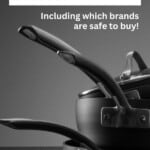
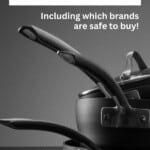
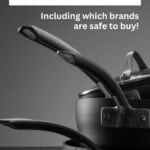
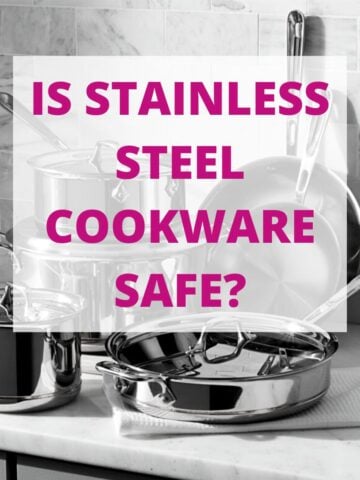
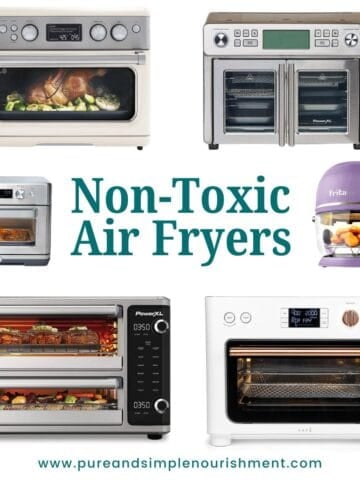
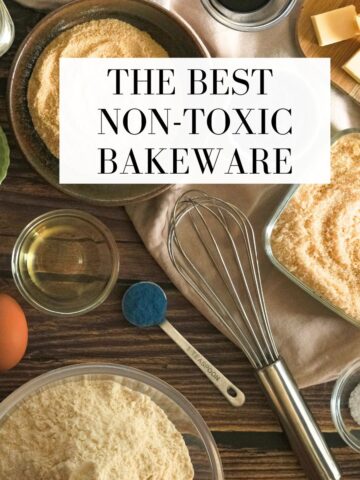
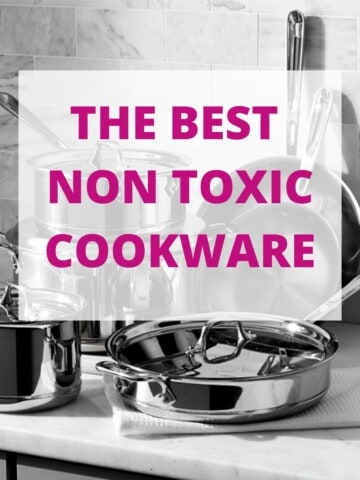
S.
What about German Silit brand?
Erin Carter
I can't find any details on what they use in their ceramic coatings so I can't recommend that brand without knowing more.
Kenya Wilkins
Excellent article. I bought a sunblock for my kids with titanium dioxide and zinc, thinking it was beneficial. Thank you for all the information.
Erin Carter
I'm glad you found it helpful! Those ingredients are great in sunscreen though. They don't get absorbed so they don't have the same risks as ingesting them. I have a whole article about that if you are interested in reading more:
https://www.pureandsimplenourishment.com/is-mineral-or-chemical-sunscreen-better/
Gina
Do you know anything about MasterClass ceramic sold in Marshall's?
Erin Carter
I looked them up and couldn't find any information on what ingredients they use in their ceramic coatings so I wouldn't recommend them without knowing what's in them.
sedat
this article is amazing, thank you
Erin Carter
I'm so glad it was helpful!
FranqB
Thanks for the post, it looks like your extrema code isn't working
Erin Carter
Thanks so much for letting me know! I reached out to Xtrema and it should be working now!
Tony
Amazing article. You are a superior journalist and extremely knowledgable. Question though… i read alot of ceramic cook aware have lead? Xtrema doesnt mention anything about being lead free.
Erin Carter
Hey Tony!
Thanks for reading. And yes Xtrema is lead free. Here is their info on it: https://xtrema.ca/pages/product-testing
Yi
Xtrema cookware is ceramic glazed. https://xtrema.ca/blogs/blog/everything-you-need-to-know-about-ceramic-coated-cookware?shpxid=0b072f84-3338-4f71-91d4-18a5161935d1
Erin Carter
Hi Yi!
Yes they use a pure ceramic core, which is coated with a pure ceramic glaze (so they are 100% ceramic) and it's then all tested for heavy metals to ensure it's safe. The issues with some other glazes on ceramic is that they are not always pure ceramic and can be contaminated with heavy metals.
I hope that helps!
Yi
Hi Erin, I like this article very much. Thank you very much!